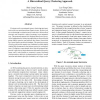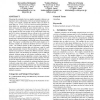41 search results - page 2 / 9 » WISE-cluster: clustering e-commerce search engines automatic... |
ICDM
2002
IEEE
14 years 12 days ago
2002
IEEE
Previous works on automatic query clustering most generate a flat, un-nested partition of query terms. In this work, we are pursuing to organize query terms into a hierarchical s...
PAMI
2012
11 years 10 months ago
2012
—Web-scale image search engines (e.g. Google Image Search, Bing Image Search) mostly rely on surrounding text features. It is difficult for them to interpret users’ search int...
INTR
2010
13 years 6 months ago
2010
Purpose – Web search engines are frequently used by people to locate information on the Internet. However, not all queries have an informational goal. Instead of information, so...
WSDM
2009
ACM
14 years 2 months ago
2009
ACM
Measuring the similarity between implicit semantic relations is an important task in information retrieval and natural language processing. For example, consider the situation whe...
APWEB
2004
Springer
14 years 26 days ago
2004
Springer
Today, search engine is the most commonly used tool for Web information retrieval, however, its current status is still far from satisfaction. This paper focuses on clustering Web...


